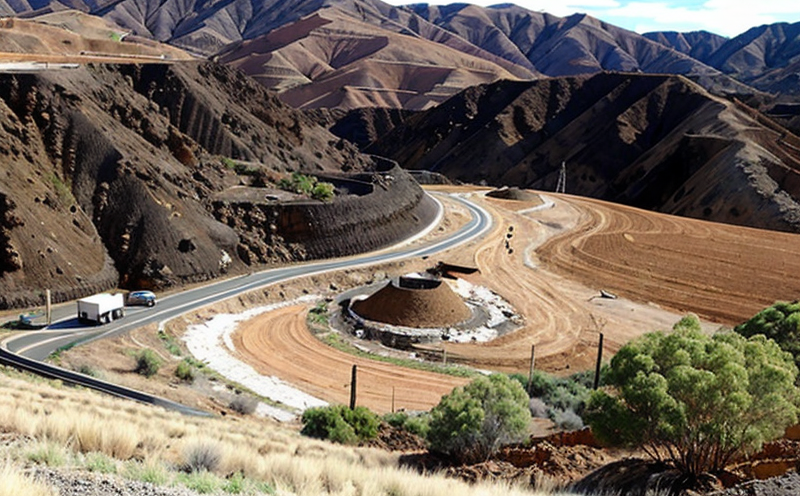DIN 38409 Chemical Oxygen Demand in Runoff Water from Restored Sites
The testing of chemical oxygen demand (COD) in runoff water from restored mine sites is crucial for ensuring the ecological restoration and sustainability of mining operations. DIN 38409, a German standard, provides specific guidelines for determining the COD content in such waters to assess the effectiveness of rehabilitation efforts.
COD measures the amount of oxygen required to oxidize organic matter present in water samples under controlled conditions. In mine rehabilitation, understanding and monitoring this parameter is essential because it indicates the presence and concentration of pollutants that could negatively impact local ecosystems. This test helps quality managers and compliance officers ensure that their rehabilitation projects meet environmental standards set by international bodies like ISO.
The process involves collecting runoff water from restored sites using appropriate sampling techniques. Samples are then prepared according to DIN 38409 procedures, which include dilution steps tailored to the initial COD concentration levels present in the sample. The testing itself is conducted using a closed digestion system where the sample reacts with a potassium dichromate solution under acidic conditions and at high temperatures (typically around 2 hours at 150°C).
Accurate measurement of COD is vital for determining whether the rehabilitation efforts are achieving their intended goals. By comparing pre- and post-rehabilitation COD levels, stakeholders can evaluate the success rate of land restoration projects. This information is critical not only from an ecological standpoint but also in terms of regulatory compliance.
The international acceptance and recognition of DIN 38409 emphasize its reliability as a benchmark for evaluating water quality following mine site rehabilitation. Its widespread use across various countries underscores its significance in the mining industry's global efforts towards sustainability.
Why Choose This Test
Selecting the right testing method is fundamental to achieving accurate and reliable results. For mine rehabilitation projects, DIN 38409 offers several advantages:
- Precision: The standard provides detailed protocols ensuring consistent results across different laboratories.
- Regulatory Compliance: Adherence to internationally recognized standards like DIN 38409 ensures that your rehabilitation efforts meet stringent environmental regulations.
- Cost-Effectiveness: By using a well-established and widely accepted method, you can avoid the need for developing custom tests which would be more time-consuming and expensive.
The precision of DIN 38409 allows stakeholders to make informed decisions about the effectiveness of their rehabilitation strategies. Regulatory compliance is crucial in ensuring that your projects are not only environmentally responsible but also legally sound. Cost-effectiveness ensures efficient resource allocation, allowing for more comprehensive rehabilitation efforts with available budget.
International Acceptance and Recognition
DIN 38409 has gained significant acceptance and recognition within the international community due to its robust methodology and consistency in results. This standard is widely adopted by various organizations involved in environmental protection, including government agencies, NGOs, and private companies.
One of the key reasons for this widespread adoption is that DIN 38409 aligns closely with other internationally recognized standards such as ISO 16032 and ASTM D5959. These standards provide a harmonized approach to assessing COD levels, which enhances comparability between different jurisdictions.
The acceptance of DIN 38409 also extends beyond mere compliance; it plays a pivotal role in fostering collaboration among stakeholders worldwide. By using a universally accepted method, all parties involved can share data with confidence knowing that the results are comparable and valid across borders.
Use Cases and Application Examples
The use of DIN 38409 COD testing in runoff water from mine sites is not limited to academic research but also finds practical application in real-world scenarios. Here are some examples:
- Pre- and Post-Rehabilitation Studies: Comparing the COD levels before and after rehabilitation provides valuable insights into the effectiveness of different strategies.
- Monitoring Continuous Efforts: Regular monitoring allows for continuous improvement in rehabilitation practices, ensuring long-term sustainability.
- Comparative Studies Between Sites: This helps identify best practices and areas needing more attention.
In addition to these applications, DIN 38409 COD testing also supports decision-making processes related to investment in rehabilitation projects. By providing concrete evidence of the impact of different approaches, it aids in prioritizing resources effectively.





